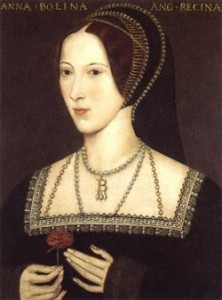 On this day in 1533, Queen Anne Boleyn went through one of the rituals associated with childbirth: “taking her chamber”.
On this day in 1533, Queen Anne Boleyn went through one of the rituals associated with childbirth: “taking her chamber”.
A Tudor woman usually took to her chamber, or went into confinement, four to six weeks before her due date but Anne took to her chamber on 26th August 1533, less than 2 weeks before Elizabeth was born. Elizabeth may have been premature, Anne may have miscalculated her dates or she may have purposely entered confinement late to suggest that Elizabeth had been conceived legitimately. Historian Eric Ives1 suggests that the rapid appointment of Thomas Cranmer as Archbishop of Canterbury, the promotion of Thomas Audley, the burst of parliamentary drafting and the hurried secret ceremony on 25th January 1533 were because Anne suddenly realised that she was pregnant. However, conception was hard to recognise in the early stages of pregnancy so this burst of activity may simply have been because the couple were sleeping together and were therefore risking pregnancy.
Anne’s “taking her chamber” ceremony took place at Greenwich Palace. A heavily pregnant Queen Anne Boleyn attended a special mass at the palace’s Chapel Royal and then processed with her ladies to the Queen’s great chamber. There, the group enjoyed wine and spices before Anne’s lord chamberlain prayed that God would give the Queen a safe delivery. After the prayer, Anne and her ladies retired to her chamber, which, from that moment on, would be a male-free zone.
The fifteenth century “Royalle Book”2, and the ordinances added to it by Lady Margaret Beaufort, stipulated that the birthing chamber should:
- Be carpeted
- Have its walls, ceilings and windows covered with blue arras – These beautiful tapestries were to have calming and romantic images
- Have one window slightly uncovered to let in light and air when needed
- Be furnished with a bed for the Queen and a pallet at the foot of it – The Queen would give birth on the pallet and it was set at a height appropriate for the midwife. It was set up close to the fire and away from cold draughts.
- Have soft furnishings of crimson satin embroidered with gold crowns and the Queen’s arms
- Have an altar
- Have a tapestry covered cupboard to house the birthing equipment and swaddling bands
- Have a font in case of a sickly baby needing to be baptised straight after the birth
- Have a display of gold and silver plate items from the Jewel House3 – It was important for the Queen and her baby to be surrounded by symbols of her wealth and status.
Birth rooms were fastened up against fresh air, which was thought to be harmful, candles were lit in the darkened room and special objects to speed delivery were brought in – objects such as amulets, relics of saints and herbs. It was thought that this womb-like chamber would protect the baby from evil spirits as it came into the world. The woman was advised to remove all types of knots, fastenings, laces, buckles and rings so that she wouldn’t be restricted in any way and so that they wouldn’t get in the way. This was also a symbolic gesture with their removal being seen as promoting an easier birth.
Although “taking her chamber” is often referred to as “confinement”, the woman was not actually alone. Men were banned from the chamber, but close female friends and relatives joined the woman there and a Queen would have a certain number of her ladies. It was a social occasion and when the labour began the ladies would spring into action helping the midwife and making the caudle, which was a spiced wine or ale that was given to the woman during labour to give her strength.
The birthing chamber, which sounds as if it would have been rather stifling in a hot August, was to be Anne Boleyn’s home until she was churched thirty days after the birth. Fortunately for Anne, her baby came sooner than expected and she gave birth to a girl, the future Elizabeth I, on the 7th September 1533.
(Unedited extract from Claire Ridgway’s upcoming book “The Anne Boleyn Collection II”)
Notes and Sources
- Ives, Eric (2004) The Life and Death of Anne Boleyn, Wiley-Blackwell, p170
- Edwards, John (2011) Mary I: England’s Catholic Queen, Yale University Press, p5
- Starkey, David (2001) Elizabeth: Apprenticeship, Vintage Books, p2